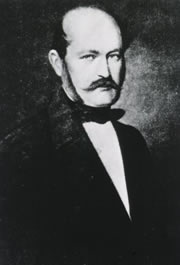|
Ignaz Semmelweis, MD (1818- 1865). Born in Budapest as Ign?c F?l?p Semmelweis, he started his university studies as a lawyer, but changed to Medicine and in 1844, at the age of 26, attained his MD degree. in 1847 he was appointed as an assistant in Obstetrics, almost at the same time of the death of a friend (Kolletschka, a pathologist) who died of what appeared to be "puerperal fever", also known as "childbed fever" after being accidentally stabbed by a knife during the autopsy of a female who had died of that disease. Semmelweis reasoned that the disease somehow was transmitted via the wound and started a crusade to have surgeons and students clean their hands with a carbolized solution before examining a healthy pregnant woman.
Although the obstetric wards under his care reduced the rate of this disease to almost nothing, Semmelweis endured criticism from his teachers, colleagues, and peers, and he did not make any friends by calling "murderers" those who did not follow his ideas. murderers". An excerpt of a letter to one of this detractors reads: "I denounce you before God and the world as a murderer and the history of puerperal fever will not do you an injustice when for the service of having been the first to oppose my life-saving technique it perpetuates your name as a medical Nero". He did not publish his findings until later in life, and then received even more criticism.
In 1865 was committed to an mental asylum only to die a few days later. He was only 47 years old. The same year he died Joseph Lister performed the first operations using antiseptic technique.
|

Original image courtesy of
Images from the History of Medicine.
|
Sources:
1. NEWSOM S." PIONEERS IN INFECTION CONTROL - SEMMELWEIS,IGNAZ,PHILIPP". The Journal of hospital infection. 1993-03-01;23:175-187.
2. Ellis, H. (2008). Ignaz Semmelweis: tragic pioneer in the prevention of puerperal sepsis. British Journal Of Hospital Medicine (London, England: 2005), 69(6), 358
3. " A Corner of History: Ignaz Philipp Semmelweis" Wynder, EL Prev Med 3" (4) Dec 1974, 574-580
4. "Ignaz Semmeweis; a hand-washing pioneer" P. Rangapa JAPI May 2010 58:328
|



